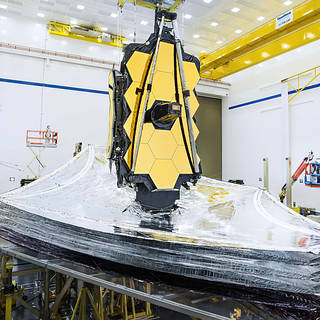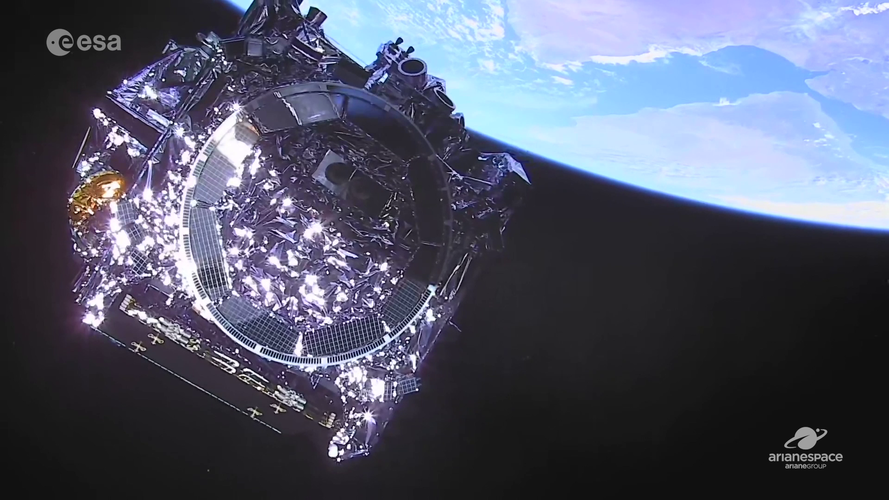
Copernical Team
Saturday, 01 January 2022 00:56
Bezos' Blue Origin teams up with U.S. military 'rocket cargo' program
Washington DC (UPI) Jan 01, 2022
 Jeff Bezos' Blue Origin has teamed up with the U.S. military to explore the possibility of using rockets to transport cargo and people, U.S. Transportation Command announced Monday.
The Amazon founder's Blue Origin rocket company and USTRANSCOM, which oversees global military logistics, signed the cooperative research and development agreement, CRADA, on Dec. 17, according to the announcem
Jeff Bezos' Blue Origin has teamed up with the U.S. military to explore the possibility of using rockets to transport cargo and people, U.S. Transportation Command announced Monday.
The Amazon founder's Blue Origin rocket company and USTRANSCOM, which oversees global military logistics, signed the cooperative research and development agreement, CRADA, on Dec. 17, according to the announcem
 Jeff Bezos' Blue Origin has teamed up with the U.S. military to explore the possibility of using rockets to transport cargo and people, U.S. Transportation Command announced Monday.
The Amazon founder's Blue Origin rocket company and USTRANSCOM, which oversees global military logistics, signed the cooperative research and development agreement, CRADA, on Dec. 17, according to the announcem
Jeff Bezos' Blue Origin has teamed up with the U.S. military to explore the possibility of using rockets to transport cargo and people, U.S. Transportation Command announced Monday.
The Amazon founder's Blue Origin rocket company and USTRANSCOM, which oversees global military logistics, signed the cooperative research and development agreement, CRADA, on Dec. 17, according to the announcem
Published in
News
Tagged under
Saturday, 01 January 2022 00:56
US Govt orders Polyakov to sell Firefly Aerospace stake
Moscow (Sputnik) Jan 01, 2022
 The businessman revitalised the space company using his own funds back in 2017, when it was on the brink of bankruptcy. Since then, the firm secured its first contracts with the US government and held a partially successful first launch of a satellite.
The US government demanded Ukrainian software mogul Max Polyakov to sell his entire stake in the space company Firefly Aerospace, which man
The businessman revitalised the space company using his own funds back in 2017, when it was on the brink of bankruptcy. Since then, the firm secured its first contracts with the US government and held a partially successful first launch of a satellite.
The US government demanded Ukrainian software mogul Max Polyakov to sell his entire stake in the space company Firefly Aerospace, which man
 The businessman revitalised the space company using his own funds back in 2017, when it was on the brink of bankruptcy. Since then, the firm secured its first contracts with the US government and held a partially successful first launch of a satellite.
The US government demanded Ukrainian software mogul Max Polyakov to sell his entire stake in the space company Firefly Aerospace, which man
The businessman revitalised the space company using his own funds back in 2017, when it was on the brink of bankruptcy. Since then, the firm secured its first contracts with the US government and held a partially successful first launch of a satellite.
The US government demanded Ukrainian software mogul Max Polyakov to sell his entire stake in the space company Firefly Aerospace, which man
Published in
News
Tagged under
Thursday, 30 December 2021 15:12
Update: NASA Plans Coverage of Webb Space Telescope Deployments
 Over about the next two weeks, NASA will provide broadcast coverage, media briefings, and other updates on major deployment milestones for the James Webb Space Telescope, the world’s largest and most powerful space science telescope.
Over about the next two weeks, NASA will provide broadcast coverage, media briefings, and other updates on major deployment milestones for the James Webb Space Telescope, the world’s largest and most powerful space science telescope.
Published in
News
Tagged under
Thursday, 30 December 2021 12:56
Iranian state TV says Tehran launched rocket into space

Published in
News
Tagged under
Thursday, 30 December 2021 15:12
NASA Plans Coverage of Webb Space Telescope Deployments
 Over about the next two weeks, NASA will provide broadcast coverage, a media briefing, and other updates on major deployment milestones for the James Webb Space Telescope, the world’s largest and most powerful space science telescope.
Over about the next two weeks, NASA will provide broadcast coverage, a media briefing, and other updates on major deployment milestones for the James Webb Space Telescope, the world’s largest and most powerful space science telescope.
Published in
News
Tagged under
Thursday, 30 December 2021 13:00
Webb separation from Ariane 5
 Video:
00:03:04
Video:
00:03:04
This real-time video shows the separation of the James Webb Space Telescope from the Ariane 5 launch vehicle and the subsequent solar array deployment.
Webb’s launch on an ESA-provided Ariane 5 rocket was performed by Arianespace on behalf of ESA from Europe’s Spaceport in French Guiana, at 12:20:07 GMT (13:20:07 CET) on 25 December 2021.
Webb separation from the Ariane 5 occurred at 12:47:14 GMT (13:47:14 CET) with solar array deployment starting 69 seconds later.
Thanks to Ariane 5’s highly precise launch trajectory Webb’s solar array was able to deploy soon after separation from the Ariane 5, capturing sunlight to
Published in
News
Tagged under
Thursday, 30 December 2021 11:49
Putin hails multiple launch test of hypersonic missile
Moscow (AFP) Dec 24, 2021
 President Vladimir Putin said Friday the Russian military successfully fired a simultaneous salvo of its Zircon hypersonic missiles, calling it "a big event" for the country.
As world powers race to develop advanced weaponry, Russia has carried out a number of successful tests of its Zircon hypersonic cruise missile.
This was however the first time that Russian authorities reported a su
President Vladimir Putin said Friday the Russian military successfully fired a simultaneous salvo of its Zircon hypersonic missiles, calling it "a big event" for the country.
As world powers race to develop advanced weaponry, Russia has carried out a number of successful tests of its Zircon hypersonic cruise missile.
This was however the first time that Russian authorities reported a su
 President Vladimir Putin said Friday the Russian military successfully fired a simultaneous salvo of its Zircon hypersonic missiles, calling it "a big event" for the country.
As world powers race to develop advanced weaponry, Russia has carried out a number of successful tests of its Zircon hypersonic cruise missile.
This was however the first time that Russian authorities reported a su
President Vladimir Putin said Friday the Russian military successfully fired a simultaneous salvo of its Zircon hypersonic missiles, calling it "a big event" for the country.
As world powers race to develop advanced weaponry, Russia has carried out a number of successful tests of its Zircon hypersonic cruise missile.
This was however the first time that Russian authorities reported a su
Published in
News
Tagged under
Thursday, 30 December 2021 07:31
China launches Tianhui 4 satellite into orbit
Beijing (XNA) Dec 30, 2021
 China launched the Tianhui 4 satellite into space on Wednesday evening from the Jiuquan Satellite Launch Center in northwestern China's Gobi Desert, according to China Aerospace Science and Technology Corp.
The State-owned space contractor said the satellite was deployed by a Long March 2D carrier rocket that blasted off at 7:13 pm and has entered orbit.
Tianhui 4, built by the compa
China launched the Tianhui 4 satellite into space on Wednesday evening from the Jiuquan Satellite Launch Center in northwestern China's Gobi Desert, according to China Aerospace Science and Technology Corp.
The State-owned space contractor said the satellite was deployed by a Long March 2D carrier rocket that blasted off at 7:13 pm and has entered orbit.
Tianhui 4, built by the compa
 China launched the Tianhui 4 satellite into space on Wednesday evening from the Jiuquan Satellite Launch Center in northwestern China's Gobi Desert, according to China Aerospace Science and Technology Corp.
The State-owned space contractor said the satellite was deployed by a Long March 2D carrier rocket that blasted off at 7:13 pm and has entered orbit.
Tianhui 4, built by the compa
China launched the Tianhui 4 satellite into space on Wednesday evening from the Jiuquan Satellite Launch Center in northwestern China's Gobi Desert, according to China Aerospace Science and Technology Corp.
The State-owned space contractor said the satellite was deployed by a Long March 2D carrier rocket that blasted off at 7:13 pm and has entered orbit.
Tianhui 4, built by the compa
Published in
News
Tagged under
Thursday, 30 December 2021 07:31
Satellogic to build high-throughput manufacturing plant in Netherlands
Charlotte NC (SPX) Dec 30, 2021
 Satellogic, a leader in sub-meter resolution satellite imagery collection, announced that it will be constructing a high-throughput satellite manufacturing facility in the Netherlands.
This 57,000 square foot new location is expected to accelerate the company's assembly of satellites and accommodate its state-of-the-art manufacturing, integration, and testing equipment. In addition to havi
Satellogic, a leader in sub-meter resolution satellite imagery collection, announced that it will be constructing a high-throughput satellite manufacturing facility in the Netherlands.
This 57,000 square foot new location is expected to accelerate the company's assembly of satellites and accommodate its state-of-the-art manufacturing, integration, and testing equipment. In addition to havi
 Satellogic, a leader in sub-meter resolution satellite imagery collection, announced that it will be constructing a high-throughput satellite manufacturing facility in the Netherlands.
This 57,000 square foot new location is expected to accelerate the company's assembly of satellites and accommodate its state-of-the-art manufacturing, integration, and testing equipment. In addition to havi
Satellogic, a leader in sub-meter resolution satellite imagery collection, announced that it will be constructing a high-throughput satellite manufacturing facility in the Netherlands.
This 57,000 square foot new location is expected to accelerate the company's assembly of satellites and accommodate its state-of-the-art manufacturing, integration, and testing equipment. In addition to havi
Published in
News
Tagged under
Thursday, 30 December 2021 07:31
James Webb telescope completes tower extension
Washington DC (UPI) Dec 29, 2021
 The James Webb Space Telescope continued to deploy perfectly Wednesday as it flew over 360,000 miles from Earth on a million-plus-mile journey to its destination.
The latest maneuver for the $10 billion observatory was to extend its Deployable Tower Assembly, which hoists the giant gold reflective mirror a little further from the thruster and heat shield.
The tower extension occu
The James Webb Space Telescope continued to deploy perfectly Wednesday as it flew over 360,000 miles from Earth on a million-plus-mile journey to its destination.
The latest maneuver for the $10 billion observatory was to extend its Deployable Tower Assembly, which hoists the giant gold reflective mirror a little further from the thruster and heat shield.
The tower extension occu
 The James Webb Space Telescope continued to deploy perfectly Wednesday as it flew over 360,000 miles from Earth on a million-plus-mile journey to its destination.
The latest maneuver for the $10 billion observatory was to extend its Deployable Tower Assembly, which hoists the giant gold reflective mirror a little further from the thruster and heat shield.
The tower extension occu
The James Webb Space Telescope continued to deploy perfectly Wednesday as it flew over 360,000 miles from Earth on a million-plus-mile journey to its destination.
The latest maneuver for the $10 billion observatory was to extend its Deployable Tower Assembly, which hoists the giant gold reflective mirror a little further from the thruster and heat shield.
The tower extension occu
Published in
News
Tagged under

